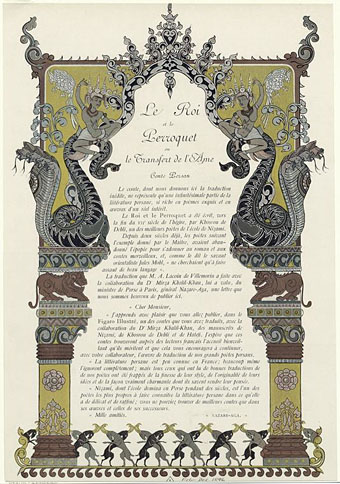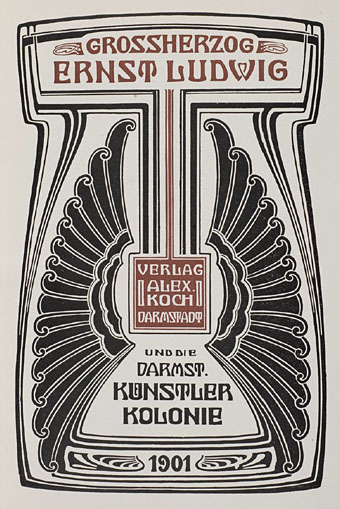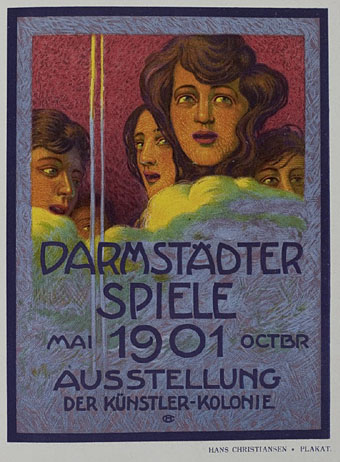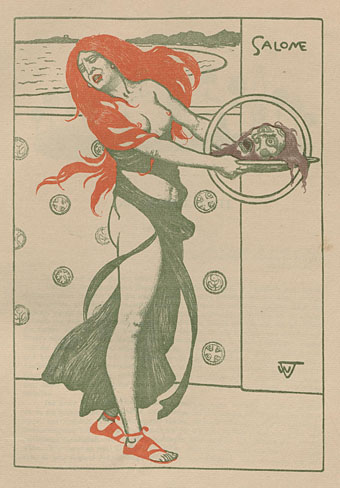I’ve been having trouble doing anything online today due to a recurrent fault with the phone line so here’s something florid and serpentine from Figaro illustré for December, 1896. The title is something about a king and a parrot but that’s as much as I’m able to tell you.
Category: {magazines}
Magazines
Darmstadt documents
More from the University of Heidelberg’s treasure trove of digitised books, Die Ausstellung der Darmstädter Künstler-Kolonie (1901) is also related to Deustche Kunst und Dekoration by being a product of that journal’s publisher, Alexander Koch. The book showcases the work and philosophy of the Darmstadt art and design colony, many of whose artworks and architecture designs were featured in DK&D. Since having gone through the back issues of Koch’s journal I’ve become increasingly fascinated by the Darmstadt group and their contemporaries in the Wiener Werkstätte so finding a handful of new documents is very welcome, even if much of the work is now familiar. The continual use of the square at this period of German and Austrian design is particularly notable (Ver Sacrum, lest we forget, was a square-format magazine) and square motifs have been feeding into my own work in various ways recently, some of which will be revealed here soon.
Also in the Heidelberg archive are some related publications, Ein Dokument deutscher Kunst: die Ausstellung der Künstler-Kolonie in Darmstadt (1901) by Peter Behrens, and Die Ausstellung der Künstler-Kolonie Darmstadt (1902) by Joseph Maria Olbrich, several pages of German text but it does include a plan of the colony grounds.
Previously on { feuilleton }
• Ver Sacrum, 1898
Deutsche Kunst und Dekoration #3
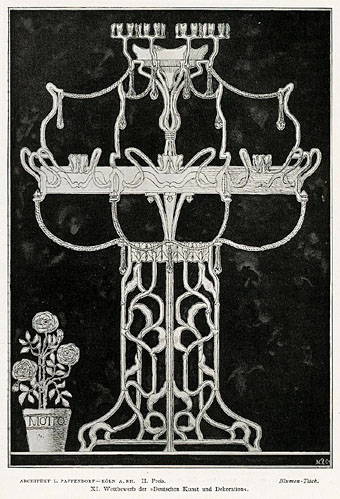
A slight return to Deutsche Kunst und Dekoration, the German periodical of art and decoration. Volume 3, which covers the period from October 1898 to March 1899, was missing from the copies stored at the Internet Archive but has recently been added to the burgeoning collection of books and journals being digitised at the University of Heidelberg. What might have been a frustrating omission turns out to be less interesting than some of the editions which followed but it still features plenty of examples of the German Art Nouveau style.

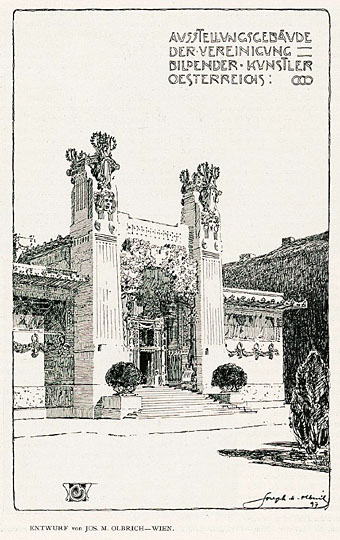
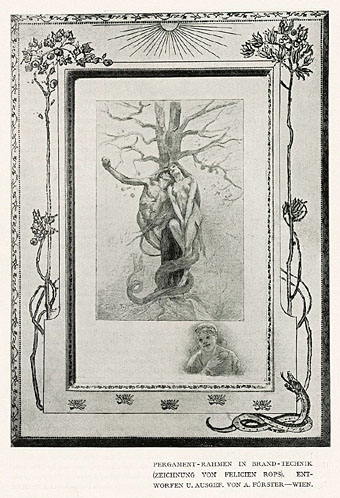
Eritis Similis Deo (They were like God) (1896) by Félicien Rops.
Previously on { feuilleton }
• Deutsche Kunst und Dekoration #25
• Deutsche Kunst und Dekoration #24
• Deutsche Kunst und Dekoration #23
• Deutsche Kunst und Dekoration #22
• Deutsche Kunst und Dekoration #21
• Deutsche Kunst und Dekoration #20
• Deutsche Kunst und Dekoration #19
• Deutsche Kunst und Dekoration #18
• Deutsche Kunst und Dekoration #16
• Deutsche Kunst und Dekoration #15
• Deutsche Kunst und Dekoration #12
• Deutsche Kunst und Dekoration #11
• Deutsche Kunst und Dekoration #10: Turin and Vienna
• Deutsche Kunst und Dekoration #10: Heinrich Vogeler
• Deutsche Kunst und Dekoration #9
• Deutsche Kunst und Dekoration #8
• Deutsche Kunst und Dekoration #7
• Deutsche Kunst und Dekoration #6
• Deutsche Kunst und Dekoration #5
• Deutsche Kunst und Dekoration #4
• Deutsche Kunst und Dekoration #2
• Deutsche Kunst und Dekoration #1
• Deutsche Kunst und Dekoration
• Jugend Magazine revisited
The art of Ludwig von Hofmann, 1861–1945
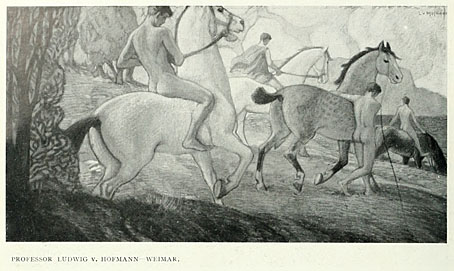
Ludwig von Hofmann was a German artist whose work has already appeared via the above example from Deutsche Kunst und Dekoration. Many of Hofmann’s drawings and paintings appeared in that magazine’s rival publication, Pan magazine, for which the artist also provided a cover design for the collected editions, and vignettes for the interiors.
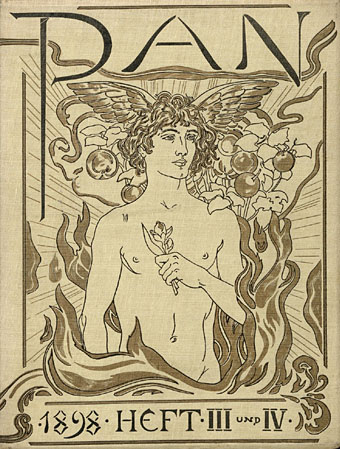
Hofmann is also of note for those of us who search art history for potentially gay art or artists. A handful of his works turn up continually on forums where homoerotic artwork is posted even though I’ve yet to see any evidence that his desires ran in this direction. It’s true that many of Hofmann’s pictures focus exclusively on the naked male form, but it’s equally true that he painted and drew a large number of naked women. Males and females often appear together in Adam and Eve pictures, a theme which was so common in German art at this time it’s easy to assume that most artists were using the subject as the merest excuse to represent the unclothed figure.
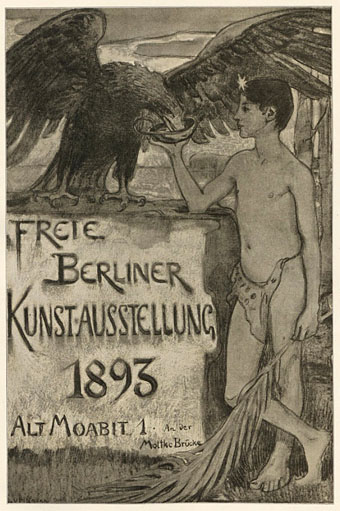
Ganymede poster design from Pan (1895).
Biographical details state that Hofmann married his cousin in 1899 although he still may have been bisexual, of course. If I was making a case for a Uranian inclination in his art I’d point to his poster design on the Ganymede theme (a favourite among gay artists with its story of Zeus falling for a beautiful boy), his many drawings of bathing boys and naked riders on horseback (the latter seems an obsession), Thomas Mann’s admiration for his work, and at least one sketch of a boy from Capri, an island with a long history as a favourite holiday resort for the rich and famous homosexuals of Europe. Whatever the truth, many of Hofmann’s pictures remain homoerotic, intentionally or not, and a few further examples are posted here. I should note that two of the pictures have been cropped to focus on the male figures, and that many of them lack verifiable dates.
Wilhelm Volz’s Salomé
Wilhelm Volz (1855–1901) was a German artist whose work I might not have paid any attention to at all had this lithograph not been featured in that cult volume Dreamers of Decadence. As a composition it’s a lot more interesting than Volz’s paintings, the circle for a halo being an unusual detail. There’s also more of an atmosphere of horror in this representation than one usually finds with the Salomé theme. The temptress doesn’t seem very enamored of her trophy, and John the Baptist’s head for once bears a suitable expression of horror. Volz’s print was published in Pan magazine in 1896, the entire edition of which may be viewed here.
Elsewhere on { feuilleton }
• The Salomé archive

